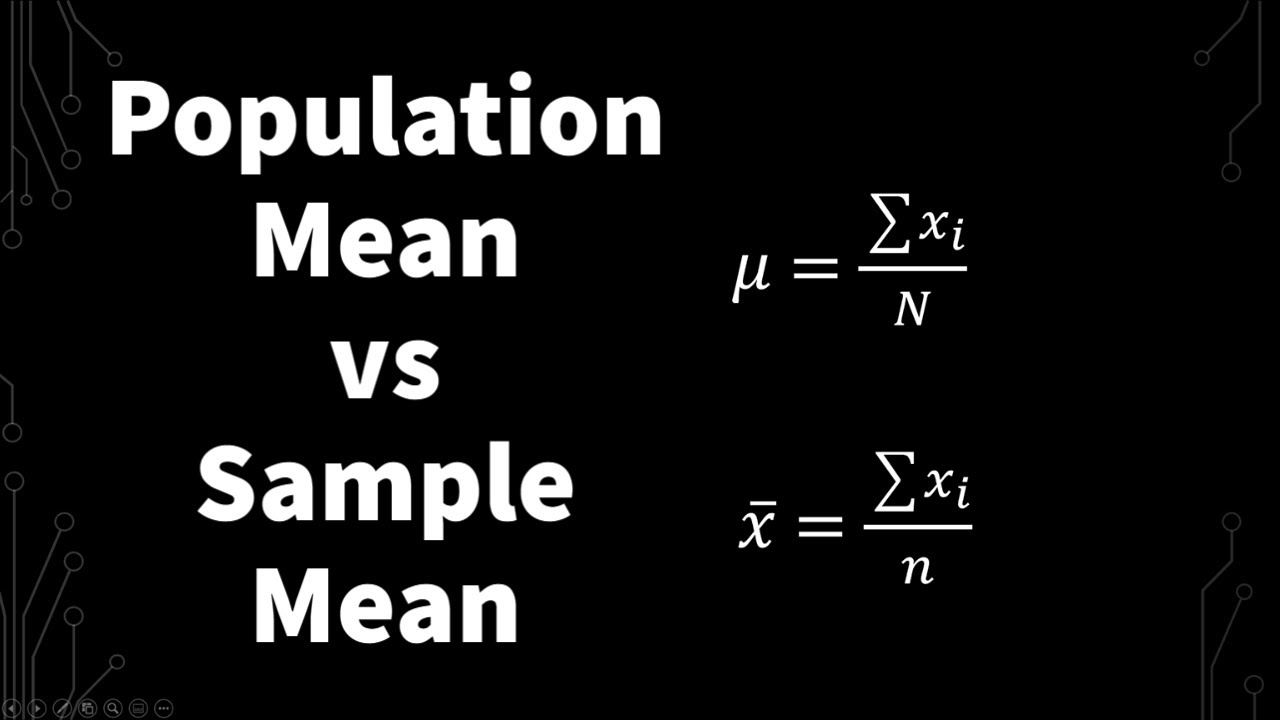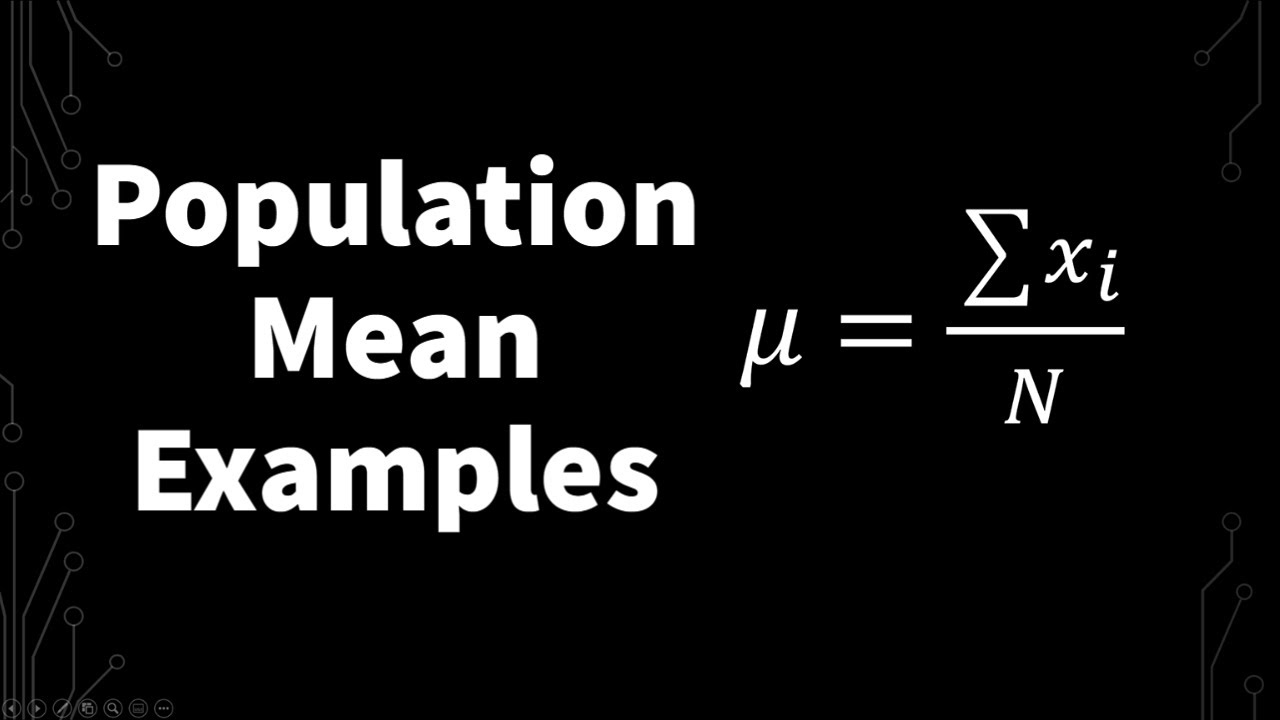Sample Mean and Population Mean - Statistics
TLDRThe video explains the difference between a sample and a population, using a city of 100,000 people as an example of a population. A sample of 100 people is used to estimate characteristics of the overall population, like the average weight. The sample mean calculates the average of the sample while the population mean calculates the average of the entire population. Increasing the sample size improves the estimate of the population mean. The sample mean is a statistic while the population mean is a parameter. Formulas are provided for calculating the sample mean and population mean, which differ only in using n for the sample size and N for the total population size.
Takeaways
- 😀 The population refers to the entire group we want to study, while the sample is a subset of the population we measure.
- 👥 We take a sample because it's impractical to measure an entire population.
- 📊 The sample mean (x-bar) is the sum of the sample data values divided by the sample size (n).
- 📈 The population mean (μ) is the sum of all the population data values divided by the total population size (N).
- 🎯 We want the sample mean to best estimate the population mean. Increasing the sample size helps it approach the actual population mean.
- i The sample mean is a statistic - a measure of a sample. The population mean is a parameter - a measure of a population.
- 🧮 The formula for sample mean sums the sample data values from x1 to xn, divided by sample size n.
- 🧮 The formula for population mean sums the population data values from x1 to xN, divided by population size N.
- 🔢 Sample size (n) and population size (N) are key components of these formulas.
- 📝 In summary, the sample mean estimates the population mean. Increasing sample size improves this estimate.
Q & A
What is the difference between a sample and a population?
-A population refers to the entire group you want to study or make conclusions about. A sample is a subset of the population that is used to estimate characteristics of the whole population.
How is the sample mean calculated?
-The sample mean is calculated by summing all the observed values in the sample and dividing by the number of items in the sample (n). The formula is Σx/n.
What is the formula for calculating the population mean?
-The formula for the population mean is Σx/N, where N represents the number of individuals in the entire population.
Why is it impractical to measure the entire population in this example?
-In this example, the population size is 100,000 people. Attempting to measure the weight of 100,000 people would require significant time and resources, so a sample is used instead to estimate the average weight.
What is the trade-off between sample size and accuracy?
-Larger sample sizes lead to more accurate estimates of the population mean, but require more effort and resources to collect data. Smaller samples are easier to obtain but may be less precise.
What terms are used to refer to the sample mean and the population mean?
-The sample mean is referred to as a statistic. The population mean is referred to as a parameter.
As sample size increases, how does the sample mean change relative to the population mean?
-As the sample size increases, the sample mean approaches and gets closer to the actual population mean.
What Greek letter represents the population mean?
-The Greek letter mu (μ) represents the population mean.
What notation is used to represent summing values in statistics formulas?
-Sigma (Σ) notation is used to represent summing values in statistical formulas.
What are some examples of statistics that describe a sample?
-Examples of sample statistics include the sample mean, sample median, sample mode, and sample standard deviation.
Outlines
😀 Defining Sample vs Population
The first paragraph defines the key difference between a sample and a population. A population refers to the entire group we want to study - it could be all the people living in a city. A sample is a subset of that population that we actually collect data from. For example, we may survey 100 people out of a city of 100,000 to estimate characteristics about the overall city population.
😃 Calculating Sample and Population Means
The second paragraph explains how to calculate the sample mean versus the population mean. The sample mean takes the sum of the sample data values divided by the sample size n. The population mean takes the sum of all the population data values divided by the total population size N. We want the sample mean to approximate the population mean. Increasing the sample size n makes the sample mean approach the actual population mean more closely.
😊 Sample Mean vs Population Parameter
The third paragraph distinguishes between a sample statistic like the sample mean, versus a population parameter like the population mean. The sample mean is considered a statistic, while the population mean is a parameter. Other examples of statistics are median, mode, etc. calculated on a sample, while parameters describe the overall population.
📝 Formulas for Sample and Population Means
The fourth paragraph presents the mathematical formulas for calculating the sample mean and population mean. The formulas sum up the sample or population data values respectively and divide by the sample size n or total population size N. The formulas look very similar, differing only in using lowercase n versus uppercase N to represent if it is a sample or population calculation.
Mindmap
Keywords
💡sample
💡population
💡sample mean
💡population mean
💡statistic
💡parameter
💡formulas
💡accuracy
💡estimate
💡approach
Highlights
The population refers to the entire group we want to study
A sample is a subset of the population that is used to estimate characteristics of the whole population
The sample mean is calculated by summing the sample data values and dividing by the sample size n
The population mean sums data values of the entire population and divides by population size N
The sample mean is a statistic - a measure of the sample
The population mean is a parameter - a measure of the population
Increasing the sample size improves the estimate of the population mean
Larger sample size requires more effort to collect data
Sample mean formula sums the sample data values from x1 to xn, divided by sample size n
Population mean formula is similar but sums values for entire population from x1 to xN, divided by N
Lowercase n represents sample size
Capital N represents population size
Sample mean is calculated by summing sample data values and dividing by sample size n
Population mean formula sums all population data values and divides by population size N
Sample mean uses lowercase n for sample size
Population mean uses capital N for total population size
Formulas for sample and population mean are similar with only difference being sample size n vs. population size N
Now you know formulas for calculating sample mean and population mean
Transcripts
Browse More Related Video

Population Mean And Sample Mean (Explanation and Walkthrough Example) |Statistics

Another simulation giving evidence that (n-1) gives us an unbiased estimate of variance

Simulation showing bias in sample variance | Probability and Statistics | Khan Academy

How to Calculate Population Mean (Parameter and Examples) | Statistics

Symbols in statistics. Sample or Population?

The Sample Variance: Why Divide by n-1?
5.0 / 5 (0 votes)
Thanks for rating: